疑问句(一般疑问句、特殊疑问句)公开课教学课件教程文件
- 格式:ppt
- 大小:676.00 KB
- 文档页数:38
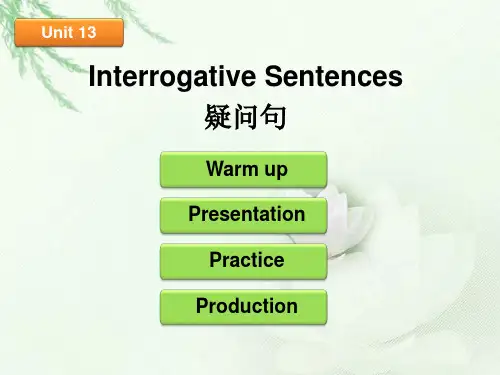
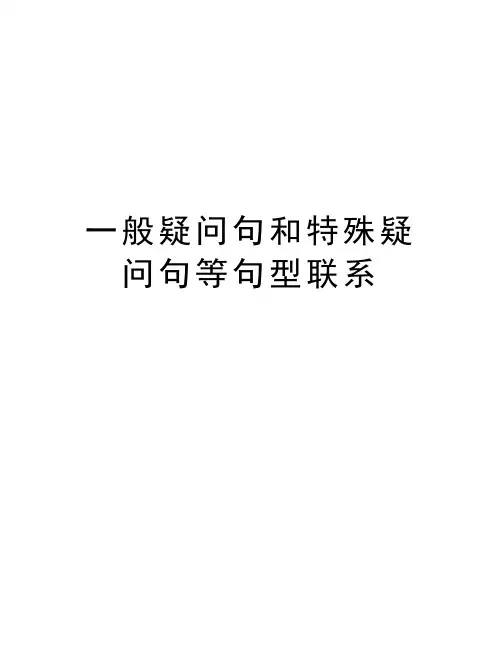
一般疑问句和特殊疑问句等句型联系一般疑问句和特殊疑问句一、一般疑问句be动词(am, is are)肯定:Yes, 主语+引导词引导词 can/will/should等情态动词答语do/does/did助动词否定:No, 主语+引导词+not二、特殊疑问句(即由特殊疑问词引导的疑问句)特殊疑问词有:when, where, who, what, whose, why, howbe动词(am, is are)特殊疑问词+ can/will/should等情态动词 + 主语 + 谓语 + 其他 do/does/did助动词改写否定句型be动词 + notcan/will/should等情态动词 + not主语 + do/does/did + not + 谓语动词感叹句的表述What + a/an + 形容词 + 名词例:What an interesting film!How + 形容词 + 主语 + 谓语例:How interesting the film is!补充知识点动词原形如:buy(买)1、be going to + 地点如:the park打算 ... 时间如:on Monday2、want to + 动词原形表示“想要...”3、在......转弯用介词“at”, 如turn left at.../turn right at4、like + V-ing, 如:He likes playing basketball.5、by + 交通工具,表示交通方式。
6、go to + 地点,表示“去...”; get to + 地点,表示“到...”7、next to 挨着;near 在...附近; in front of... 在...前面;behind... 在...后面8、be far from... 离...远的句型转换练习题一、改成一般疑问句1、He is a student.2、She can dance.3、You like apples.二、改成否定句1、He is a student.2、She can dance.3、You like apples.三、对划线部分提问1、He goes to school by bus.2、He is a coach.3、The hospital is near the bookstore.4、I am going to the cinema tomorrow.四、改成感叹句1、The cinema is great.2、The girl is beautiful.补充实义动词动词单三形式将括号里动词的适当形式填入横线上。
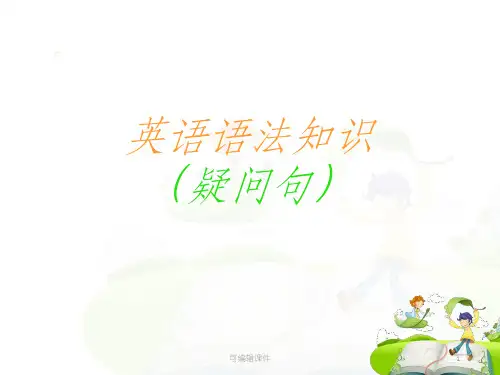
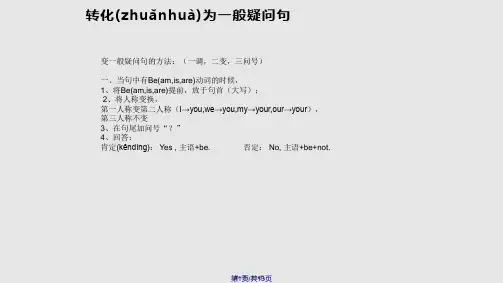
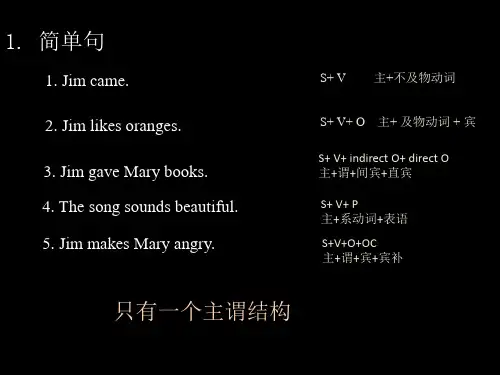
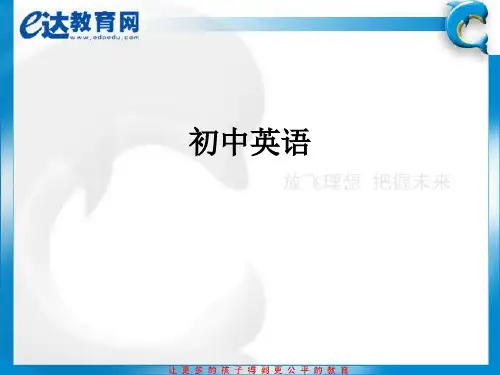
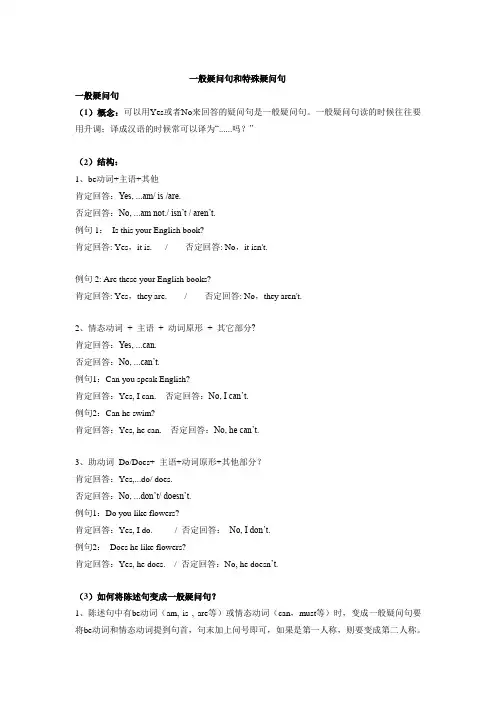
一般疑问句和特殊疑问句一般疑问句(1)概念:可以用Yes或者No来回答的疑问句是一般疑问句。
一般疑问句读的时候往往要用升调;译成汉语的时候常可以译为“......吗?”(2)结构:1、be动词+主语+其他肯定回答:Yes, ...am/ is /are.否定回答:No, ...am not./ isn’t / aren’t.例句1:Is this your English book?肯定回答: Yes,it is. / 否定回答: No,it isn't.例句2: Are these your English books?肯定回答: Yes,they are. / 否定回答: No,they aren't.2、情态动词+ 主语+ 动词原形+ 其它部分?肯定回答:Yes, ...can.否定回答:No, ...can’t.例句1:Can you speak English?肯定回答:Yes, I can. 否定回答:No, I can’t.例句2:Can he swim?肯定回答:Yes, he can. 否定回答:No, he can’t.3、助动词Do/Does+ 主语+动词原形+其他部分?肯定回答:Yes,...do/ does.否定回答:No, ...don’t/ doesn’t.例句1:Do you like flowers?肯定回答:Yes, I do. / 否定回答:No, I don’t.例句2:Does he like flowers?肯定回答:Yes, he does. / 否定回答:No, he doesn’t.(3)如何将陈述句变成一般疑问句?1、陈述句中有be动词(am, is , are等)或情态动词(can,must等)时,变成一般疑问句要将be动词和情态动词提到句首,句末加上问号即可,如果是第一人称,则要变成第二人称。
例如:She is a clever girl. → Is she a clever girl?I can swim. → Can you swim?2、句子里面含有实义动词(如like, likes, have,has, run, swim, jump等)。

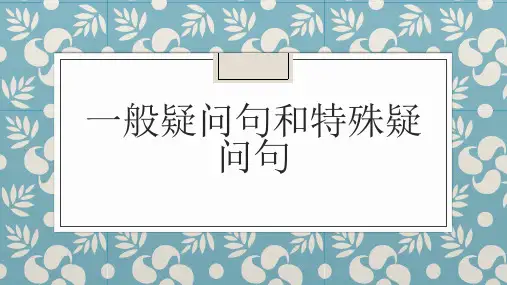
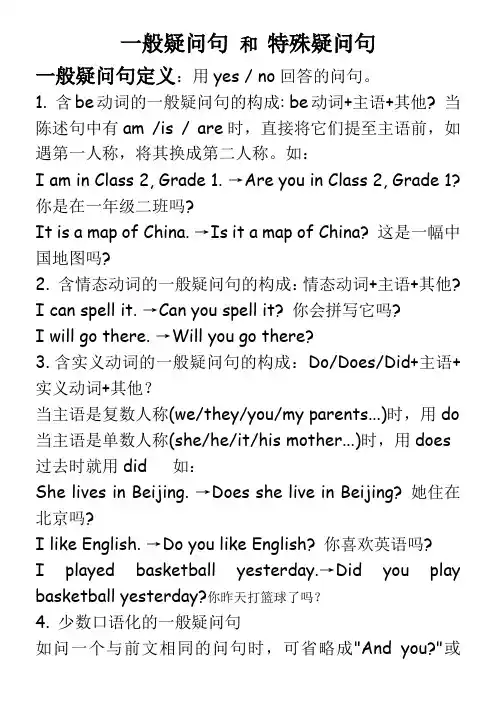
一般疑问句和特殊疑问句一般疑问句定义:用yes / no回答的问句。
1. 含be动词的一般疑问句的构成: be动词+主语+其他? 当陈述句中有am /is / are时,直接将它们提至主语前,如遇第一人称,将其换成第二人称。
如:I am in Class 2, Grade 1. →Are you in Class 2, Grade 1? 你是在一年级二班吗?It is a map of China. →Is it a map of China? 这是一幅中国地图吗?2. 含情态动词的一般疑问句的构成:情态动词+主语+其他?I can spell it. →Can you spell it? 你会拼写它吗?I will go there. →Will you go there?3.含实义动词的一般疑问句的构成:Do/Does/Did+主语+实义动词+其他?当主语是复数人称(we/they/you/my parents...)时,用do 当主语是单数人称(she/he/it/his mother...)时,用does 过去时就用did 如:She lives in Beijing. →Does she live in Beijing? 她住在北京吗?I like English. →Do you like English? 你喜欢英语吗?I played basketball yesterday.→Did you play basketball yesterday?你昨天打篮球了吗?4. 少数口语化的一般疑问句如问一个与前文相同的问句时,可省略成"And you?"或"What / How about...?"等;甚至只抓关键词,读作升调。
如:Your pen? 你的钢笔?5. 大部分的一般疑问句都应读作升调(↗),并落在最后一个单词身上。
如:Is it a Chinese car↗?6. 一般疑问句的应答用yes / no(或相当于yes / no的词)回答,并怎么问怎么答(句首为情态动词am / is / are还是do /does),简略回答时要注意缩写(否定的n't)和采用相应的人称代词以避免重复:即"Yes,主语(代词)+情态动词或am / is / are或do / does."表示肯定;"No,主语(代词)+情态动词或am / is / are 或者do / does not(n't)."表示否定.如:① Is Mary a Japanese girl? 玛丽是日本女孩吗? Yes, she is. / No, she isn't. 是的,她是。
